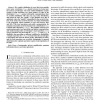132 search results - page 15 / 27 » On Public Key Encryption from Noisy Codewords |
SCN
2010
Springer
14 years 9 months ago
2010
Springer
This paper introduces and explores the new concept of Time-Specific Encryption (TSE). In (Plain) TSE, a Time Server broadcasts a key at the beginning of each time unit, a Time Inst...
111
click to vote
DCC
2007
IEEE
15 years 10 months ago
2007
IEEE
A general method for deriving an identity-based public key cryptosystem from a one-way function is described. We construct both ID-based signature schemes and ID-based encryption ...
117
click to vote
CRYPTO
2009
Springer
15 years 5 months ago
2009
Springer
We present a new methodology for proving security of encryption systems using what we call Dual System Encryption. Our techniques result in fully secure Identity-Based Encryption ...
CORR
2006
Springer
14 years 11 months ago
2006
Springer
We consider distillation of secret bits from partially secret noisy correlations PABE, shared between two honest parties and an eavesdropper. The most studied distillation scenario...
EUROCRYPT
2009
Springer
15 years 11 months ago
2009
Springer
A group key agreement (GKA) protocol allows a set of users to establish a common secret via open networks. Observing that a major goal of GKAs for most applications is to establish...

